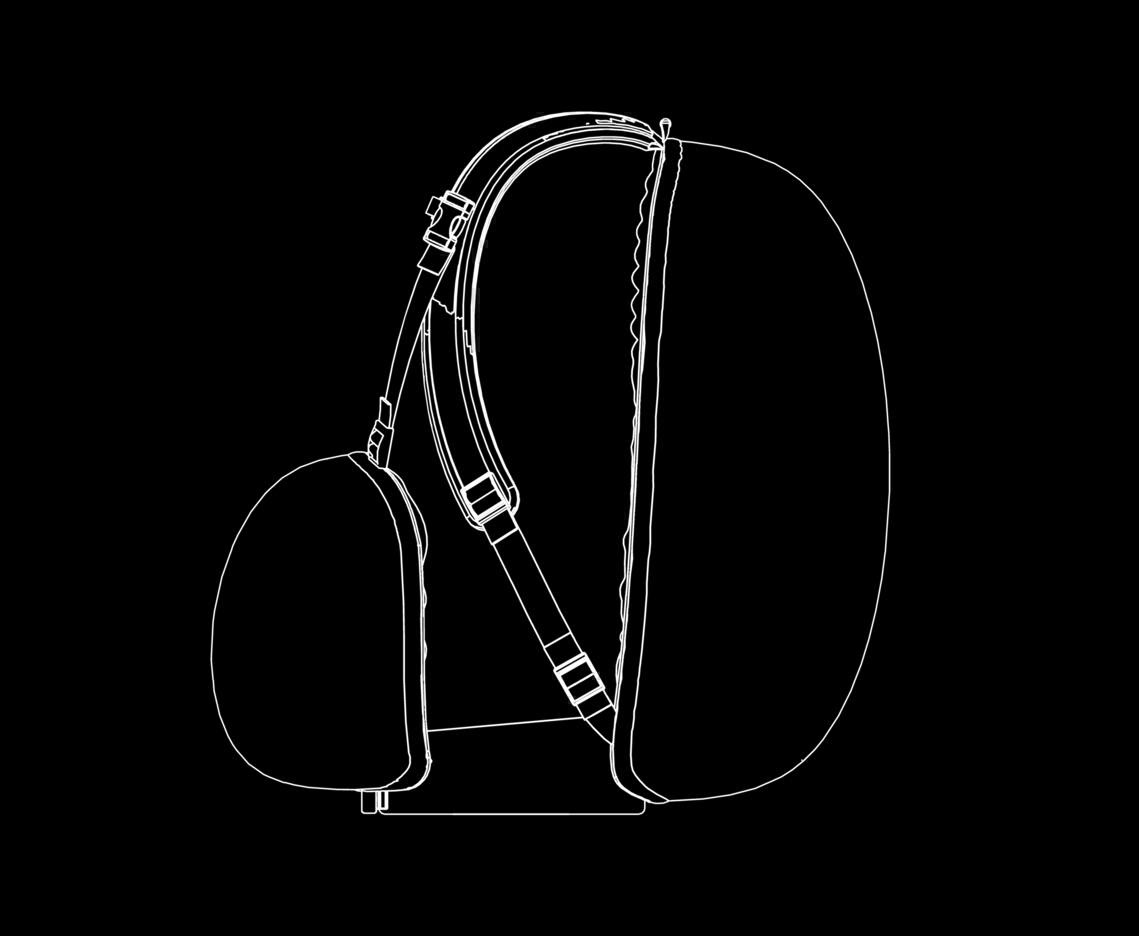Db - Double Bag
"The objective is to “fool” the body, integrating the weight as if it was an extraorganic extension."

First principle - balance
The most radical innovation in the system used by this backpack is the particular attention paid to the user's balance. For this purpose the load unit must be separated into two main modules, placed on the two opposite sides of the spine (if they have the same weight they can eliminate the moment applied to the back. There are no modules to be applied to the sides, in order to do not limit the movement of the upper limbs. The two modules do not have the same dimensions, since on the back the available surface is greater while on the front side it is necessary to leave a space reserved for the expansion of the lungs during the act of inspiration. For these reasons the front module is smaller than the rear one.
Even if the dimensions of the two modules are different, the balance can be found by separating small objects from large ones. In fact, in the world of hiking and camping in general, a sort of rule is observable, according to which the most bulky objects are those that weigh less while the smaller ones are the heaviest.
This "rule" allows the user to plan in which part he prefers to load specific things, thus obtaining the desired balance according to the activity he will carry out. On a horizontal plane, in fact, it is preferable to have a balance between the two parts; walking on a long climb, it is preferable, on the other hand, to have little weight on the back, in order not to create an exaggerated forward bend (in fact, the human body in itself already naturally assumes a forward folded position during the climb).

Second principle - internal distribution
It has already been seen how the load unit undergoes a clear change, dividing into two parts, with the aim of obtaining balance. The same division exists inside, for various reasons: on a physiological level, the reduction of the moment stressed on the spine increases if the mass of the load is in a position closer to the axis of the spine. The separation of the entire mass into several overlapping parts eliminates the concentration of heavy objects that are deposited on the bottom, thus allowing you to choose which cell to place each object in. In this way it is possible to put into practice the method which consists in superimposing a light and large mass on a smaller heavy one; in this way the second one is compressed towards the back. This function makes the content easily accessible and well ordered, divided by weight, delicacy of the objects, thermal insulation or other user needs. The cells represent the equipment containers and have universal dimensions; to improve comfort, however, different types of cells of various sizes and materials have been designed, which can meet the needs of thermal insulation, insulation from humidity, impact protection, etc.

Third principle - modularity
The division of the content allows you to decide how to arrange the weight inside the two main parts, given that the possibility of detaching the various pockets increases the flexibility of the configuration of the entire system. The user can decide whether to apply the pockets on the front or on the back. Obviously, the things you need during the walk will be placed on the front, and when, for example, a bottle of liquid is used up, the hiker will be able to recover the missing weight to get back the system budget, simply by bringing an object in front of it. previously it was in the back. This function can be exploited in different ways and create various combinations; for example, two users who exploit this system are able to easily share and exchange their load. A camper who wishes to take a short trip carrying only the bare essentials, can safely leave entire pockets in the tent, using only the back of the backpack for his trip.

Fourth principle - access to content
In classic backpacks the main opening is located on the upper side, i.e. on the narrower side of the volume. Access to content is thus limited to the width of the backpack itself, and to access the objects on the bottom, those above must be extracted, causing some disturbance to the user. The position of the desired object can be any, it is not well defined, and to identify it the hiker is forced to remove the backpack and take a break. The access to the content, in this new system, takes place through the front side, the widest, thus allowing to have all the contents of the backpack freely available to the user. The pockets are exposed, the user only has to choose the one that contains the desired object; in fact, their content is visible, eliminating the riddle of where the object is located. It is natural that the content placed on the front of the backpack is accessible even on the move.

